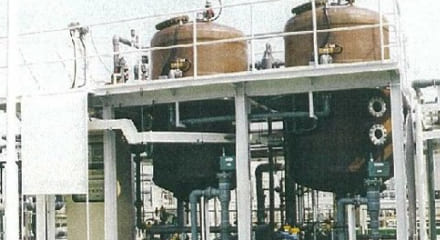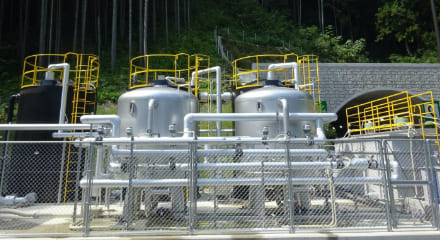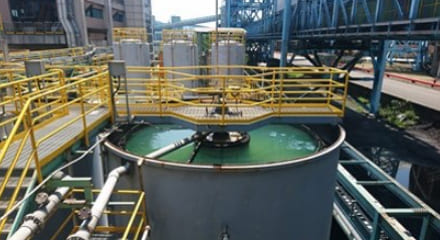Implementation examples
Examples of use of “READ” adsorbents and flocculants for water treatment
ー Examples are categorized by element and place.
-

Fluorine in the wastewater from a semiconductor plant is treated with an adsorbent after coagulating sedimentation treatment
It is believed that fluorine is an effective …
-

Treatment of detected arsenic from a tunnel springwater by using an adsorbent
Arsenic is carcinogenic and affect the hematopoietic function and immune system. It is also toxic to the liver and kidney. There are …
-

Boron in desulfurization wastewater from a thermal power station is removed using a flocculant | Additional information about adsorbents
An excessive amount of boron can adversely affect the growth …
-

Fluorine in the wastewater from a semiconductor plant is treated with an adsorbent after coagulating sedimentation treatment
It is believed that fluorine is an effective…
-

Boron in desulfurization wastewater from a thermal power station is removed using a flocculant | Additional information about adsorbents
An excessive amount of boron can adversely affect the growth …
-

Treatment of detected arsenic from a tunnel springwater by using an adsorbent
Arsenic is carcinogenic and affect the hematopoietic function and immune system. It is also toxic to the liver and kidney. There are …
-

Fluorine in the wastewater from a semiconductor plant is treated with an adsorbent after coagulating sedimentation treatment
It is believed that fluorine is an effective…
-

Treatment of detected arsenic from a tunnel springwater by using an adsorbent
Arsenic is carcinogenic and affect the hematopoietic function and immune system. It is also toxic to the liver and kidney. There are …
-

Boron in desulfurization wastewater from a thermal power station is removed using a flocculant | Additional information about adsorbents
An excessive amount of boron can adversely affect the growth …
List of other examples
Click any of the items
to view the more information
about that item.
- 01. Treating fluorine-containing wastewater from an automotive parts factory
- 02. Treating arsenic-containing well water for use at a food factory
- 03. Treating arsenic-containing spring water at a construction site
- 04. Treating arsenic-containing spring water at a tunnel
- 05. Treating arsenic-containing well water at a restaurant
- 06. Treating boron-containing wastewater from a plant
01.
Treating fluorine-containing wastewater from an automotive parts factory
| Targeted element | Fluorine |
| Installation site | Wastewater from an automotive parts factory |
| Treatment method | Coagulating sedimentation + Adsorption (“READ-F”) |
| Details | At an automotive parts factory, coagulating sedimentation is performed using calcium in a preceding stage and an adsorption tower is used for advanced treatment in a later stage to treat fluorine-containing water to a level below the wastewater standard.Regeneration is performed at night when the factory is not operating, and the desorbed dense fluorine waste liquid is returned to the preceding stage. This is combined with coagulating sedimentation to make the treatment more efficient. |
| Effect | Treatment concentration: F=15 → 5 mg/L Quantity of treated water: 15 m3/hr |
02.
Treating arsenic-containing well water for use at a food factory
| Targeted element | Arsenic |
| Installation site | Well water for use at a food factory (in two facilities) |
| Processing Method | Adsorption (“READ-As”) |
| Details | Arsenic was detected in the water of a new well at a food factory.An adsorbent-based treatment device was introduced to treat the water so that it was at or below an analysis agency's detection limit and below 0.001 mg/L. With the subsequent extension of a factory, a new well was constructed and its water was confirmed to contain arsenic.Another piece of equipment the same as the one that had been previously installed was placed next to the first. The adsorbents are regenerated at an Air Water Group factory every few months. During regeneration treatment, operations continue using only one adsorption tower.After the regeneration treatment is complete, the tower is filled again before two-tower operations resume. |
| Effect | (1) Treatment concentration: As = 0.009 → below 0.001 mg/L Quantity of treated water:200㎥/d Quantity of adsorbent:1,000L/tower×2towers (2) Treatment concentration:As=0.010→below0.001mg/L Quantity of treated water:300㎥/d Quantity of adsorbent: 1,500 L/tower x 2 towers |
03.
Treating arsenic-containing spring water on a construction site
| Targeted element | Arsenic |
| Instalation site | Spring water from a construction site |
| Processing Method | Biological treatment + adsorption (“READ-As”) |
| Details | The contamination of spring water with a high concentration of arsenic was detected during the construction of an underground structure. Since iron coprecipitation generates a large amount of sludge and it posed difficulties in the management of operations, a device combining biological treatment and an adsorption tower was introduced. A certain amount of arsenic is precipitated as an iron compound using iron in the biological contact filter tower in a preceding stage. The remaining arsenic is adsorbed in a later stage of treatment. This is an advanced treatment method. This method is easily adaptable to the changes in the amount of water that are unique to a construction site, and ensures the stability of arsenic treatment. The adsorbents undergo regeneration treatment at a factory every three months and are continuously used throughout the construction period. |
| Effect | Treatment concentration: As = 0.30 → 0.05 mg/L or below Quantity of treated water: 5,760㎥/d Biological treatment tower: 2 towers, quantity of adsorbent: 6,000 L/tower x 2 towers |
04.
Treating arsenic-containing spring water at a tunnel
| Targeted element | Arsenic |
| Installation site | Spring water from a tunnel |
| Processing Method | Adsorption (“READ-As”) |
| Details | The contamination of spring water with arsenic was detected during the excavation of a tunnel. A plant for turbid water treatment was built and the contaminated water is treated by means of coagulating sedimentation. The treated water is discharged into a river while the dewatered sludge is disposed of as specially controlled industrial waste. During the construction period, the contaminated water was managed in accordance with the wastewater standards. Immediately following the completion of construction, the management of contaminated water was shifted to environmental standards and an arsenic adsorption system was installed.Automatically operated, the arsenic-containing water is treated to a level that is at or below the environmental standard before being discharged. The adsorbents regularly undergo regeneration treatment at our plant before being reused to fill the adsorption tower. The water is simultaneously treated for the antimony it contains using the same adsorbent. Antimony is a self-regulated substance in the management zone. |
| Effect | Treatment concentration: As = 0.02 → below 0.01 mg/L, Sb = 0.1 mg/L → below 0.08 mg/L Quantity of treated water:50㎥/d Quantity of adsorbent: 200 L/tower x 2 towers |
05.
Treating arsenic-containing well water from a restaurant's driven well
| Targeted element | Arsenic |
| Where the products are used | A restaurant's driven well water |
| Processing Method | Adsorption (“READ-As”) |
| Details | The contamination of water with arsenic and antimony was detected in a restaurant's newly installed well.To remove the contaminants, a tank filled with adsorbents was installed at the restaurant to treat the contaminated water to a level below the environmental standards. The regeneration period is about 300 days. For the regeneration, the adsorbents can be removed from each tank and put into a returnable box before being sent to an Air Water Group factory. Regenerated products are sent back and placed in the tank. This is the whole process. No replenishment work has to be performed on site. Checking differential pressure is almost the only procedure necessary for the management of operations. Basically, the tank is left to stand except during regeneration. |
| Effect |
Treatment concentration: As = 0.019 → below 0.01 mg/L Quantity of treated water:5㎥/d Quantity of adsorbent: 100 L/tank x 2, one activated carbon tank |
06.
Treating boron-containing wastewater from a plant
| Targeted element | Boron |
| Installation site | Wastewater from a plant |
| Processing Method | Adsorption (“READ-B”) |
| Details | To achieve a machine parts factory's in-house standard, 5 mg/L or less, wastewater is sent to a tank filled with “READ-B (MC)” boron adsorbents and treated. Periodically, a tank containing resin is sent back to our plant and undergoes regeneration treatment. The recycled resin is continuously reused. |
| Effect |
Treatment concentration: B = 10 → 5 mg/L or below Quantity of treated water:3㎥/d |
Q.Do you have a catalog for READ water treatment technology?
Yes. We have leaflets and technical documents for each of the elements. Please feel free to ask for it.
Q.Can I have a sample of adsorbent or flocculant?
Yes. We will send you a sample after consulting regarding the application of product and treatment outline.
Q. Is it possible to test a product beforehand?
We provide some samples, please contact us if you need it. We can conduct the tests, please feel free to consult us as well.
Q. Can I visit your plant?
If you wish to visit, please feel free to contact us.
